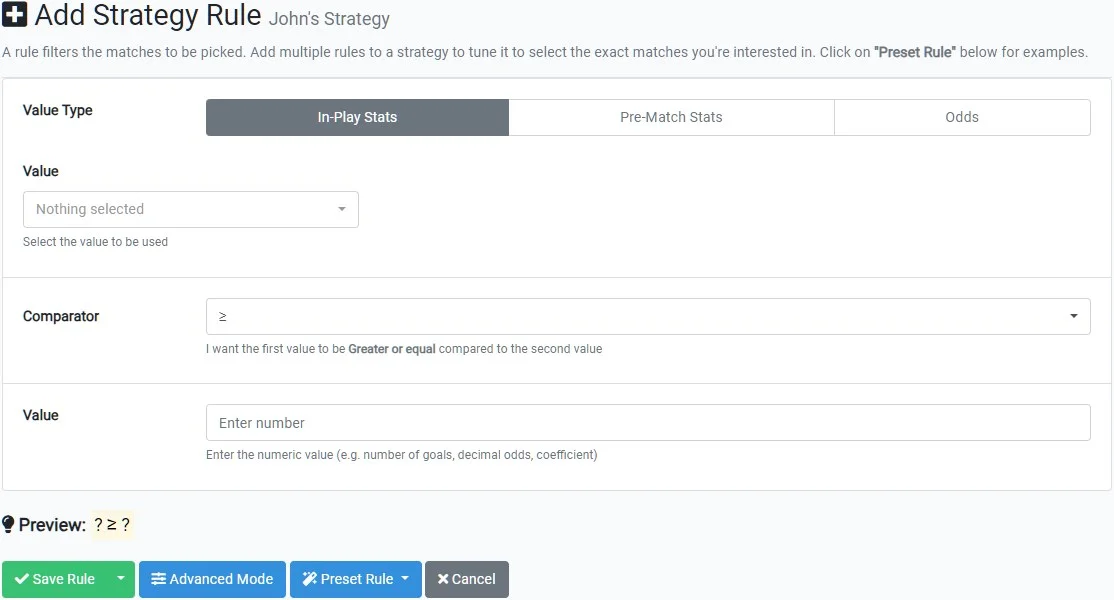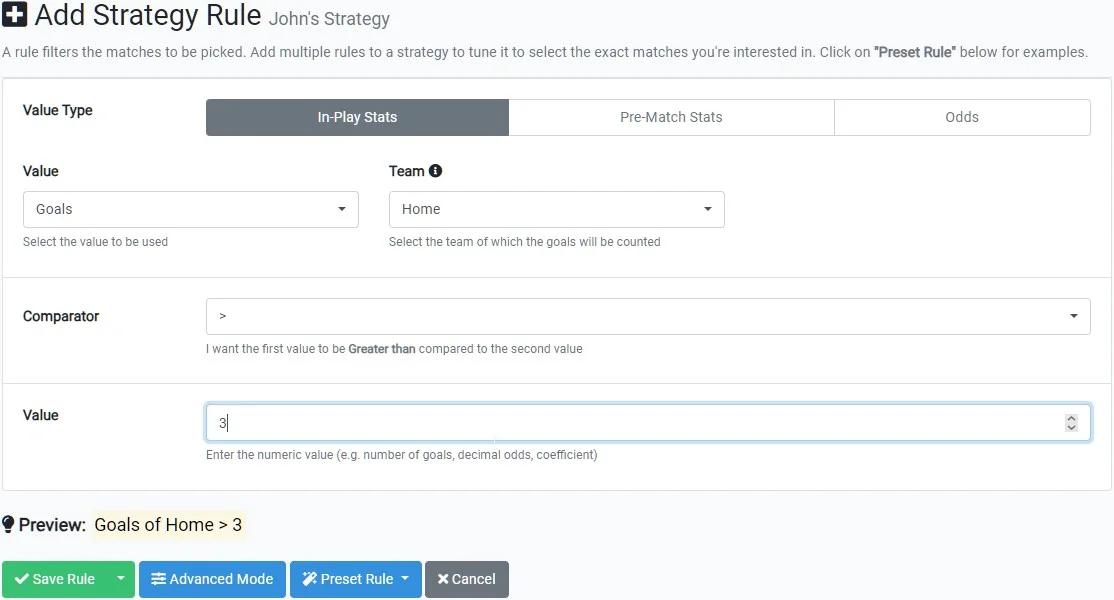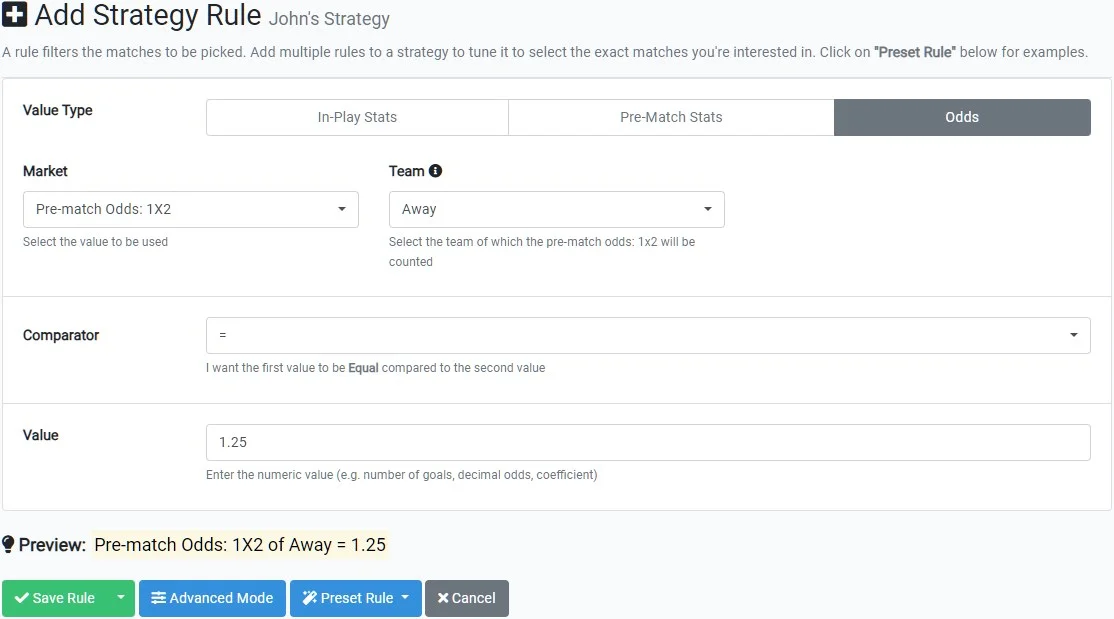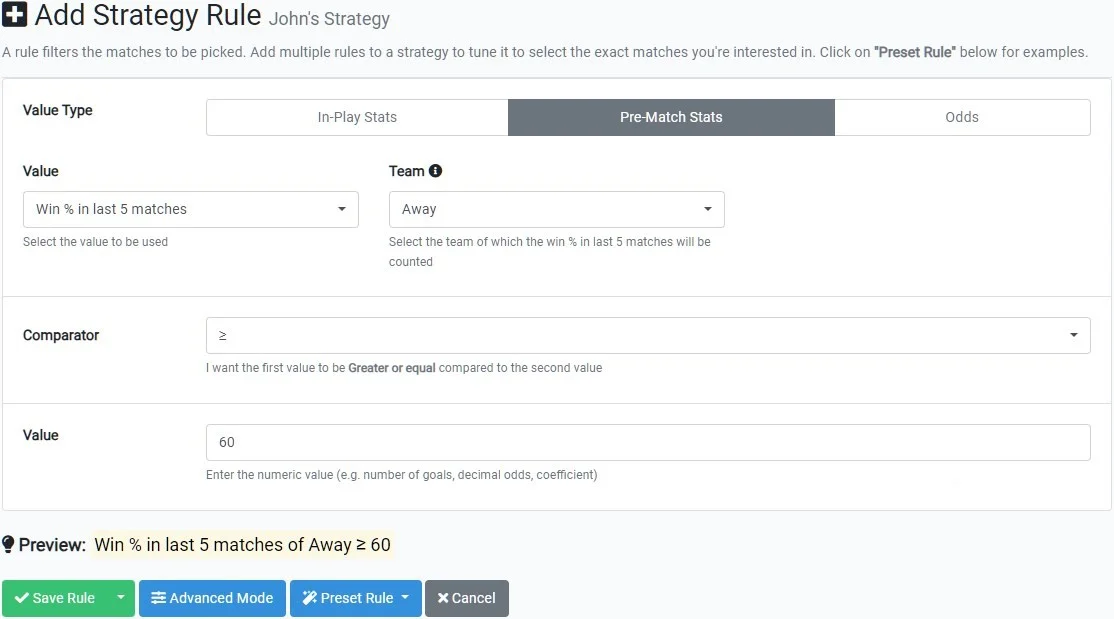Adding Rules: Easy Mode

Value Type
Select the type of value to be used as the criterion in your rule from one of the following categories:
- In-Play Stats
- Select a live metric that changes according to the game's progression.
- Pre-Match Stats
- Select a historical datapoint set before the game starts.
- Odds
- Select pre-match or live odds (that will fluctuate during the game) from an array of several available markets.
Value
In this selection box, you have the option to choose the particular data point that will serve as your criterion, depending on the section you selected earlier.
Team
If the Value you selected earlier is team-specific, a 'Team' selection box will emerge adjacent to it. It allows you to select which team you want to analyse.

Here's a listing of the available options:
- Home / Away
- The Value defined earlier will be analyzed based on data of the Home / Away team.
- Sum of teams (Total)
-
Performs a straightforward math operation: it calculates a sum by adding the selected value of both teams (Home + Away), resulting in a single, combined Total number.
This option focuses on the aggregate sum, not on whether each team separately meets the criteria. For such scenarios requiring separate evaluations for each team, you should create two distinct rules - one for each team.
When dealing with Average or Percentage values, this option DOESN'T compute a new average from these averages. Rather, it simply adds them together. Some examples:
Statistic Home Away Sum Of Teams (Total) Momentum 22 40 62 Avg. Goals (Last 5 matches) 2.1 1.8 3.9 Win % (Last 5 matches) 80% 75% 155% - Either Team / Either Team Opponent
-
Both options "Either Team" and "Either Team's Opponent" refer to the Home and Away teams playing a specific match, but analyses them in a swappable fashion.
When using the "Either Team" option, our system checks if either one of the two teams (Home or Away) meets the criteria. If Home fulfills the rule set for "Either Team", Away becomes the "Either Team's Opponent" and vice versa. This allows you to use both options together, knowing that you'll be comparing one team against another, irrespective of their side.
For example, if we want to find matches with either an exact score of 2-0 or 0-2. (i.e. one of the teams scored two goals, the other scored none). We would set two separate rules:
- Goals of Either Team = 2
- Goals of Either Team's Opponent = 0
- Difference between teams
- This option computes the numeric difference between the values of the two teams based on your selected criteria (e.g. if the score is 3-1, the difference of goals between teams is = 2).
- Favorite / Underdog
- The Favorite team in a matc is the one with the lowest closing 1X2 odds. Conversely, the Underdog is the adversary team, with the least favorable victory odds. It's essential to note that if both teams share identical closing 1X2 odds, there will be no Favorite / Underdog distinction. Consequently, any strategies relying on Favorite/Underdog rules will not apply to that specific match.
- Favorite / Underdog Playing Home/Away
- Adds a constraint that the Favorite / Underdog team must be playing at Home / Away.
- Winning / Losing team
- Uses the current score to determine which team is winning/losing and selects that team respectively. A rule using this criteria can't be fulfilled while the match is tied.
Comparator
Defines the type of comparison you want to be performed between the two values.
Value
Next, you'll select the second Value, which is a specific number that will be compared against the first Value you set. This can be an integer, such as the number of goals, a decimal like the odds value, or even a coefficient. This serves as the fixed benchmark for comparison with the variable match value you've chosen.
Rule definition examples
Let's suppose we want the home team's goals to be more than 3:

Or perhaps you aim for the Pre-Match 1X2 odds of the away team to be 1.25:

Alternatively, you might require for the away team's to have won at least 3 out of their previous 5 matches (60% Win):

Remember that you can integrate various rules to formulate a comprehensive strategy, keeping in mind that there's a maximum limit of 100 rules per strategy.
Controls Panel

- Save Rule
-
When done with editing a strategy, you should click directly on "Save Rule", and it automatically returns you to your strategies list.
Alternatively, if you wish to include more rules in the existing strategy, simply click on the menu to the right of this button and choose 'Save Rule and Create Another'. This will save the rule you've just made and allow you to proceed with designing another one immediately, enhancing your efficiency on the platform.
- Advanced Mode
- Enables Advanced Mode in the rule editor, which will stay active for any subsequent rules you create until you turn it off. More details about this mode will be provided shortly.
- Preset Rules
- You can use or draw inspiration from some common preset rules that are readily available. Click on this button, and a list of predefined common criteria will appear. Choose one, and the fields will automatically fill in. You can then make any necessary changes.
- Cancel
- Discard any changes made on this strategy, and you will be redirected to the My Strategies page.